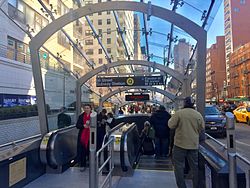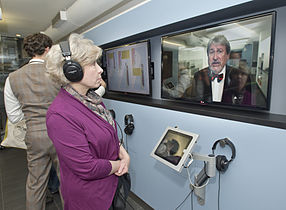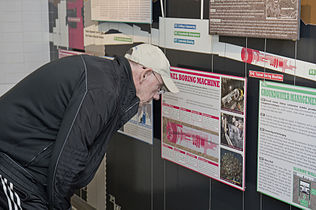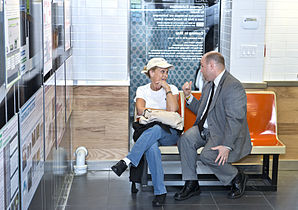86th Street station (Second Avenue Subway)
86 Street | ||||||||||||||||||||||||||||||||||||||||||||||||||||||||||||||||||||||||||||||||||
|---|---|---|---|---|---|---|---|---|---|---|---|---|---|---|---|---|---|---|---|---|---|---|---|---|---|---|---|---|---|---|---|---|---|---|---|---|---|---|---|---|---|---|---|---|---|---|---|---|---|---|---|---|---|---|---|---|---|---|---|---|---|---|---|---|---|---|---|---|---|---|---|---|---|---|---|---|---|---|---|---|---|---|
| Structure | Underground | |||||||||||||||||||||||||||||||||||||||||||||||||||||||||||||||||||||||||||||||||
| Platforms | 1 island platform | |||||||||||||||||||||||||||||||||||||||||||||||||||||||||||||||||||||||||||||||||
| Tracks | 2 | |||||||||||||||||||||||||||||||||||||||||||||||||||||||||||||||||||||||||||||||||
| Other information | ||||||||||||||||||||||||||||||||||||||||||||||||||||||||||||||||||||||||||||||||||
| Opened | January 1, 2017[3][4] | |||||||||||||||||||||||||||||||||||||||||||||||||||||||||||||||||||||||||||||||||
| Accessible | ||||||||||||||||||||||||||||||||||||||||||||||||||||||||||||||||||||||||||||||||||
| Opposite- direction transfer | Yes | |||||||||||||||||||||||||||||||||||||||||||||||||||||||||||||||||||||||||||||||||
| Traffic | ||||||||||||||||||||||||||||||||||||||||||||||||||||||||||||||||||||||||||||||||||
| 2022 | 4,881,132[5] | |||||||||||||||||||||||||||||||||||||||||||||||||||||||||||||||||||||||||||||||||
| Rank | 40 out of 423[5] | |||||||||||||||||||||||||||||||||||||||||||||||||||||||||||||||||||||||||||||||||
| ||||||||||||||||||||||||||||||||||||||||||||||||||||||||||||||||||||||||||||||||||
| ||||||||||||||||||||||||||||||||||||||||||||||||||||||||||||||||||||||||||||||||||
| ||||||||||||||||||||||||||||||||||||||||||||||||||||||||||||||||||||||||||||||||||
| ||||||||||||||||||||||||||||||||||||||||||||||||||||||||||||||||||||||||||||||||||
| ||||||||||||||||||||||||||||||||||||||||||||||||||||||||||||||||||||||||||||||||||
The 86th Street station is a station on the first phase of the Second Avenue Line of the New York City Subway. Located at the intersection of Second Avenue and 86th Street, in the Yorkville section of the Upper East Side in Manhattan, it opened on January 1, 2017. The station is served by the Q train at all times, limited southbound rush hour N trains, and one northbound A.M. rush hour R train. There are two tracks and an island platform.
The station was part of the original Second Avenue Subway as outlined in the Program for Action in 1968. Construction on that project started in 1972, but stalled in 1975 due to lack of funding. In 2007, a separate measure authorized a first phase of the Second Avenue Line to be built between 65th and 105th Streets, with stations at 72nd, 86th, and 96th Streets. The station opened on January 1, 2017, as an intermediate station along Phase 1. Since opening, the presence of the Second Avenue Subway's three Phase 1 stations has improved real estate prices along the corridor. The 86th Street station was used by approximately 8.4 million passengers in 2019.[5]
The station, along with the other Phase 1 stations along the Second Avenue Subway, contains features not found in most New York City Subway stations. It is fully compliant with the Americans with Disabilities Act of 1990, containing two elevators for disabled access. Additionally, the station contains air conditioning and is waterproofed, a feature only found in newer stations. The artwork at 86th Street is Subway Portraits, a selection of twelve face portraits by painter Chuck Close.
History


Background
The Second Avenue Line was originally proposed in 1919 as part of a
Unrealized proposals
The
All Second Avenue Subway stations built under the Program for Action would have included escalators, high intensity lighting, improved audio systems, platform edge strips, and non-slip floors to accommodate the needs of the elderly and people with disabilities, but no elevators. Space at each station would have been used for ancillary facilities.[17] The stations were to be made with brick walls and pavers alongside stainless steel, and would have relatively small dimensions, with 10-foot (3.0 m) mezzanine ceilings. Gruzen & Partners received a contract for the design of the 86th Street station.[18]: 110
A combination of Federal and State funding was obtained, and despite the controversy over the number of stops and route, a groundbreaking ceremony was held on October 27, 1972 at Second Avenue and 103rd Street.
In 1999, the Regional Plan Association considered a full-length Second Avenue Subway, which include 86th Street as one of its planned 31 stations. The main station entrance would be at 86th Street to the north, with additional exits between 86th and 82nd Streets to the south.[24]
Construction

In March 2007, plans for the construction of the Second Avenue Subway were revived.[25][26][27] The line's first phase, the "first major expansion" to the New York City Subway in more than a half-century,[28] included three stations in total (at 72nd, 86th, and 96th Streets), which collectively cost $4.45 to $4.5 billion.[29][30] Its construction site was designated as being from 105th Street and Second Avenue to 63rd Street and Third Avenue.[31] The MTA awarded a $337 million contract—one that included constructing the tunnels between 92nd and 63rd Streets, building a launch box for the tunnel boring machine (TBM) at 92nd to 95th Streets, and erecting access shafts at 69th and 72nd Streets—to Schiavone Construction, Skanska USA Civil, and J.F. Shea Construction.[32] The line's construction commenced on April 15, 2007,[25][26][33] though planning for the station was finalized in June 2007,[34] when the station entrances' locations were confirmed.[35]
On September 15, 2011, the contract for building the station was awarded to the joint venture of
The station was scheduled to be completed by May 16, 2016,[42] but the estimated completion date was pushed back to October 2016.[46][47] In October 2016, concerns arose that the station might not open on time because workers had only installed 10 of the station's 13 escalators.[48] However, the 86th Street station passed all required systems testing by December 18, 2016.[3] The station opened on January 1, 2017.[3][4]
Station layout
| Ground | Street level | Exits/entrances |
| Basement 1 | Upper landing | North entrance escalator landing |
| Basement 2 | Lower Mezzanine | Fare control, station agent, MetroCard machines |
| Basement 3 Platform level |
Southbound | ← ← |
| Island platform, doors will open on the left | ||
| Northbound | | |

The 86th Street station is served by
The station has air-cooling systems to make it at least 10 °F (6 °C) cooler than other subway stations during the summer.[56] This requires the station to have large ventilation and ancillary buildings, rather than traditional subway grates.[57] The station is also compliant with current fire codes, whereas most existing stations are not.[58] Additionally, the station is waterproofed with concrete liners and fully drained.[59] In early plans, the Second Avenue Subway was supposed to have platform screen doors to assist with air-cooling, energy savings, ventilation, and track safety,[60] but this plan was scrapped in 2012 as cost-prohibitive.[61] According to an internal study prepared for the MTA in 2020, the 86th Street station could theoretically accommodate half-height platform edge doors. Full-height platform screen doors would be possible but would necessitate the installation of structural bracing and relocation of several mechanical systems.[62]
Artwork
In 2009, MTA Arts & Design selected Chuck Close from a pool of 300 potential artists to create the artwork for the station.[63] His work consists of a series of twelve portraits of the city's cultural figures,[64] spread over 1,000 square feet (93 m2) of wall.[65][66] Each 10-foot-high (3.0 m) piece is made with tiles that are painted to create a mosaic-like effect.[67] The pieces cost $1 million and were installed near the exits and in the mezzanines.[67]

Close's portraits at the station, titled Subway Portraits, fall into two main categories. The first category of portraits comprises artists whom Close is familiar with. The station contains portraits of composer Philip Glass in his youth; musician Lou Reed; photographer Cindy Sherman; painter Cecily Brown; artist Kara Walker; and painter Alex Katz. The second category is composed of portraits of younger, more ethnically diverse artists including Zhang Huan, Sienna Shields and Pozsi B. Kolor. In these portraits, Close aimed to highlight the cultural diversity of New York City. He also has two self-portraits within the station.[63][68]
Exits and ancillary buildings

There are 3 entrances and exits, which comprise 10 escalators and one elevator.[69][70]
| Exit location[70] | Exit Type | Number of exits |
|---|---|---|
| Entrance 1 Within building at NE corner of Second Avenue and 83rd Street[2] |
Escalator | 2 escalators |
| Entrance 2 (2 entry points) NE corner of Second Avenue and 86th Street[2] |
Escalator | Each entry point has 2 escalators |
| Entrance 2 SE corner of Second Avenue and 86th Street[2] |
Elevator |
1 |
There are also two ancillary buildings that store station equipment:[71][72]
- Ancillary 1, NW corner of Second Avenue and 83rd Street
- Ancillary 2, NW corner of Second Avenue and 86th Street

Originally, Entrance 2's escalator entrance was to be located inside the Yorkshire Towers apartment building at 305 East 86th Street, on the northeast corner of Second Avenue and 86th Street. In 2009, a
Controversy emerged over Entrance 2's location in February 2011, when a lawsuit was filed by the Yorkshire Towers over the location of Entrance 2.[74][75] The entrances, planned to service 3,600 people an hour, were alleged in the lawsuit to be destroying the quality of life for building tenants, if the entrances were to be built in the location.[74] The lawsuit was later dismissed because the suit had been filed two years after the FTA's FONSI was published, which was past the statute of limitations.[76] A new lawsuit was filed on March 15, 2013, after the MTA started construction on the entrances.[76] In June 2013, that lawsuit was also dismissed.[77]
In May 2017, all three escalators in Entrance 1 were damaged by sprinklers activated by faulty sensors, causing the entire entrance to be temporarily closed.[78]
Effects
Since 2013, construction of the station has caused the value of real estate in the area to rise.[79][80] Although the surrounding area's real estate prices had been declining since the 1990s, there had been increases in the purchases and leases of residential units around the area, causing real estate prices to rise again.[81] Some businesses near the station's construction site had also lost profits.[82] With the opening of the new station, business owners hoped to see an increase in patronage.[83][84]
Second Avenue Subway Community Information Center
The Second Avenue Subway Community Information Center, which gave information about Phase I construction to community members, was located nearby, at 1628 Second Avenue between 84th and
-
Facade of Second Avenue Subway Community Information Center
-
Video exhibit
-
Sign exhibit
-
Subway car exhibit
-
Video exhibit
Nearby places
References
- ^ "Glossary". Second Avenue Subway Supplemental Draft Environmental Impact Statement (SDEIS) (PDF). Vol. 1. Metropolitan Transportation Authority. March 4, 2003. pp. 1–2. Archived from the original (PDF) on February 26, 2021. Retrieved January 1, 2021.
- ^ a b c d "Introducing the Second Avenue Subway Make Second Avenue Q subway service, your first choice". mta.info. Metropolitan Transportation Authority. December 30, 2016. Retrieved December 30, 2016.
- ^ a b c McCowan, Candace (December 31, 2016). "Decades in the making, Second Avenue Subway set to open to the public". ABC7 New York. Retrieved January 1, 2017.
- ^ a b Fitzsimmons, Emma G.; Wolfe, Jonathan (January 1, 2017). "Second Avenue Subway Opening: What to Know". The New York Times. Retrieved January 1, 2017.
- ^ a b "Annual Subway Ridership (2017–2022)". Metropolitan Transportation Authority. 2022. Retrieved November 8, 2023.
- ^ "www.nycsubway.org: Second Avenue Subway: The Line That Almost Never Was". nycsubway.org. 1972. Retrieved September 30, 2015.
- ^ ISBN 978-0-82325-369-2.
- ^ "IND Second System 1929 Plan". nycsubway.org. Retrieved March 25, 2016.
- ^ "Second Avenue Subway Project – History". October 19, 2002. Archived from the original on October 19, 2002. Retrieved February 15, 2016.
- ^ "Last Train Rumbles On Third Ave. 'El'; An Era Ends With Final Run of Third Avenue 'El' LAST TRAIN ROLLS ON THIRD AVE. 'EL'" (PDF). The New York Times. Retrieved August 23, 2016.
- ^ See:
- "2nd Avenue El". nycsubway.org. Archived from the original on January 27, 2009. Retrieved January 25, 2009.
- "Second Avenue Local". Station Reporter. Archived from the original on January 30, 2009. Retrieved January 25, 2009.
- ^ See:
- "3rd Avenue El". nycsubway.org. Archived from the original on January 27, 2009. Retrieved January 25, 2009.
- "Third Avenue Local". Station Reporter. Archived from the original on June 9, 2010. Retrieved January 25, 2009.
- ^ "The New York Transit Authority in the 1970s". nycsubway.org. Retrieved October 27, 2016.
- ^ "Draft Environmental Statement, Second Avenue Subway, Route 132-A". Urban Mass Transportation Administration. nycsubway.org. August 1971. Retrieved May 22, 2014.
- ^ a b Second Avenue Subway Final Environmental Impact Statement (FEIS), May 2004 Appendix B Development of Alternatives (PDF) (Report). Metropolitan Transportation Authority. May 2004. Archived (PDF) from the original on November 22, 2016. Retrieved August 7, 2016.
- ISSN 0362-4331. Retrieved December 25, 2016 – via New York Times Archives.
- ^ "Notice of Public Hearing Southern Extension of the Second Avenue Line for the New York City Transit System". New York Daily News. February 16, 1973. Retrieved December 8, 2018.
- OL 1130718M.
- ^ "Second Avenue Subway: Timeline". nycsubway.org. Retrieved April 7, 2014.
- ^ a b "Second Avenue Subway - History". mta.info. Metropolitan Transportation Authority. Archived from the original on April 8, 2014. Retrieved April 7, 2014.
- ^ Jewler, Sam (July 24, 2004). "The Long, Tortured History of the Second Avenue Subway". The New Yorker. Retrieved August 14, 2015.
- ^ Manhattan East Side Transit Alternatives Study (MESA): Environmental Impact Statement. 1999.
- ^ Burks, Edward C. (September 26, 1975). "Work is Stopped on Subway Line; City Lacks Funds to Finish Part of 2d Ave. Project". The New York Times. p. 41. Archived from the original on July 27, 2018. Retrieved October 4, 2015.
- ^ Metrolink Archived August 2, 2010, at the Wayback Machine, p.20
- ^ a b c "Tunneling Begins Under Second Avenue". Metropolitan Transportation Authority. May 14, 2010. Archived from the original on June 6, 2011. Retrieved June 28, 2011.
- ^ a b Neuman, William (April 9, 2007). "Is That Finally the Sound of a 2nd Ave. Subway?". The New York Times. Retrieved June 28, 2011.
- ^ "Excavation of West Tunnel for Second Avenue Subway Complete". Metropolitan Transportation Authority. February 4, 2011. Archived from the original on October 27, 2016. Retrieved October 26, 2016.
- ^ "The Second Avenue subway explained". am New York. Retrieved October 27, 2016.
- ^ *Putzier, Konrad (May 14, 2014). "Real Estate Weekly » Blog Archive » Light at end of tunnel for Second Ave. subway". Rew-online.com. Archived from the original on September 7, 2017. Retrieved June 5, 2014.
- "Project Update: Second Avenue Subway". Mass Transit. August 15, 2016. Retrieved October 27, 2016.
- ^ "Drone takes tour of NYC's 2nd Avenue subway line". CBS News. September 16, 2015. Retrieved October 27, 2016.
- ^ Nonko, Emily (January 30, 2014). "Updates on NYC's Biggest Subway Projects: Second Avenue and East Side Access". NewYork.com. Archived from the original on May 17, 2014. Retrieved June 5, 2014.
- ^ "Top Projects" (PDF). NY Construction. February 8, 2017. p. 1.
- ^ "Excavation of West Tunnel for Second Avenue Subway Complete". Metropolitan Transportation Authority. February 4, 2011. Archived from the original on October 27, 2016. Retrieved June 28, 2011.
- ^ Rubinstein, Dana (October 23, 2013). "Where is the Second Avenue Subway going?". Capital New York. Archived from the original on March 22, 2016. Retrieved May 15, 2014.
- ^ "86th Street Station Entrance at 86th Street" (PDF). Metropolitan Transportation Authority. June 26, 2007. Retrieved October 27, 2016.
- ^ "MTA Awards Contract to Build 2nd Ave Subway Station at 86th St". MTA.info. September 15, 2011. Retrieved September 15, 2011.
- ^ "Skanksa JV set to build Second Avenue's 86th St. station :: Second Ave. Sagas". Second Avenue Sagas. September 15, 2011. Retrieved May 19, 2014.
- ^ Zimmer, Amy (September 15, 2011). "Construction to Start on Second Avenue Subway's 86th Street Station". DNAinfo New York. Archived from the original on June 16, 2013. Retrieved December 19, 2016.
- ^ "February 2013 Newsletter" (PDF). MTA.info. Metropolitan Transportation Authority. February 2013.
- ^ "VIDEO: Construction of Second Ave. subway at 86th St. chugging along in NYC". NY Daily News. July 11, 2013. Archived from the original on May 19, 2014. Retrieved May 19, 2014.
- ^ "MTA | news | Second Avenue Subway Reaches Major Milestones". MTA.info. Archived from the original on May 19, 2014. Retrieved May 19, 2014.
- Crain's. Retrieved December 19, 2014.
- CBS New York. December 18, 2014. Retrieved December 19, 2014.
- ^ "Second Avenue Subway Station Shell at 86th Street Complete". Metropolitan Transportation Authority. December 18, 2014. Archived from the original on October 27, 2016. Retrieved October 27, 2016.
- ^ "April 2015 Newsletter" (PDF). MTA.info. Metropolitan Transportation Authority. April 2015.
- ^ "March 2015 report from Transit & Bus Committee" (PDF). MTA.info. Metropolitan Transportation Authority. March 2015. p. 149. Archived from the original (PDF) on April 4, 2015.
- ISSN 0362-4331. Retrieved October 27, 2016.
- ^ "SUB-DIVISION B TRAIN OPERATOR/CONDUCTOR ROAD & NON-ROAD WORK PROGRAMS IN EFFECT: NOVEMBER 6, 2016" (PDF). progressiveaction.info. New York City Transit. July 29, 2016. Retrieved August 19, 2016.
- ^ "Subway Map" (PDF). Metropolitan Transportation Authority. September 2021. Retrieved September 17, 2021.
- ^ Hession, Michael (May 2, 2014). "A Subterranean Stroll Through NYC's Newest Train Tunnel". Gizmodo. Retrieved May 13, 2014.
- ^ Rivoli, Dan (May 1, 2014). "Second Avenue Subway progress: Dec. 2016 end date on track". AM New York. Retrieved May 14, 2014.
- ^ Metropolitan Transportation Authority. "Second Avenue Subway March 2014 Public Workshop Follow-Up Report, page 23" (PDF). Retrieved April 21, 2016.
- ^ "A Tour of NYC's Newest Subway Station With Its Architect". Curbed NY. September 21, 2015. Retrieved September 24, 2015.
- MTA Capital Construction. Archived from the original(PDF) on September 23, 2015.
- ^ Donohue, Pete (August 4, 2006). "Cooler Subways Coming Eventually". New York Daily News. Archived from the original on October 10, 2007. Retrieved December 12, 2008.
- ^ Roberts, Sam (September 30, 2013). "No Heel Hazards (or Gusts) as Subway Expands". New York Times. New York. Retrieved May 5, 2014.
- NY Daily News. Retrieved May 19, 2014.
- ^ "NEW YORK CITY—Second Avenue Subway: MTA's Second Avenue Station and Tunnels Project" (PDF). Society for Mining, Metallurgy and Exploration.
- ISSN 0362-4331. Retrieved January 12, 2017.
- ^ Rubinstein, Dana (December 7, 2012). "No Seoul-style platform doors for New York subways, even in new stations". Politico.
- ^ Stv Inc. (February 2020). "New York City Transit System-wide Platform Screen Door Feasibility Study Summary of Conclusions". Metropolitan Transportation Authority. p. 3388. Retrieved January 28, 2022.
- ^ ISSN 0362-4331. Retrieved December 19, 2016.
- ^ Ben Yakas (January 22, 2014). "Here's What The Second Avenue Subway Will Look Like When It's Filled With Art". Gothamist. Archived from the original on March 30, 2014. Retrieved May 5, 2014.
- ^ Malone, Noreen (May 14, 2012). "Chuck Close Will Make the Second Avenue Subway Pretty". New York.
- ^ Mondkar, Bushan (January 22, 2014). "Subway Art on the Future Second Avenue Subway Line Revealed". Untapped Cities. Retrieved May 19, 2014.
- ^ a b Warerkar, Tanay (July 7, 2016). "Chuck Close will bring mosaic portraits to the Second Avenue Subway". Curbed NY. Retrieved December 19, 2016.
- ^ "MTA - Arts & Design | NYCT Permanent Art". web.mta.info. Retrieved May 19, 2022.
- ^ "Newsletter February 2012" (PDF). MTA.info. Metropolitan Transportation Authority. February 2012.
- ^ a b "MTA Neighborhood Maps: Upper East Side" (PDF). mta.info. Metropolitan Transportation Authority. 2016. Retrieved December 30, 2016.
- ^ "July 2015 Task Force Presentation" (PDF). MTA.info. Metropolitan Transportation Authority. July 2015. p. 36.
- ^ "August 2015 Newsletter" (PDF). MTA.info. Metropolitan Transportation Authority. August 2015.
- ^ a b c "Finding Of No Significant Impact (FONSI): Second Avenue Subway: 72nd Street and 86th Street Station Entrances" (PDF). mta.info. United States Department of Transportation. October 29, 2009. Retrieved December 19, 2016.
- ^ a b "Upper East Side Building Sues MTA Over Planned Subway Entrances". DNA Info. February 17, 2011. Archived from the original on May 19, 2014. Retrieved May 19, 2014.
- ^ "Owners and Tenants of Yorkshire Towers Sue to Relocate Planned 86th Street Entrances to Second Avenue Subway". Anderson Kill. February 17, 2011. Archived from the original on May 19, 2014. Retrieved May 19, 2014.
- ^ a b Brown, Stephen Rex (March 25, 2013). "UES residents sue MTA over Second Ave Subway entrance". NY Daily News. Retrieved December 19, 2016.
- ^ Yorkshire Towers Company, L.P. et al., v. United States Department of Transportation, et al.', 11 Civ. 1058 (TPG) (S.D.N.Y. December 1, 2011), Text.
- ^ Weaver, Shaye (May 16, 2017). "2nd Ave. Subway's 83rd St. Entrance Closed Due to Broken Escalators". DNAinfo New York. Archived from the original on September 12, 2017. Retrieved May 17, 2017.
- ^ "Shops along Second Ave. subway line construction sites want big bucks in 2014". NY Daily News. January 7, 2014. Archived from the original on March 16, 2014. Retrieved May 5, 2014.
- ^ Acitelli, Tom (March 1, 2014). "Upper East Side sees boost from Second Avenue subway progress". The Real Deal. Retrieved May 13, 2014.
- ^ Hughes, C.J. (April 8, 2016). "Yorkville Bets on the Second Avenue Subway". The New York Times. Retrieved April 13, 2016.
- ^ Schlossberg, Tatiana (October 2, 2014). "Promise of New Subways Has West Siders Excited and East Siders Skeptical". The New York Times. Retrieved October 26, 2014.
- ^ "Businesses hope for boost with 2nd Avenue subway launch". ABC7 New York. December 20, 2016. Retrieved December 23, 2016.
- ^ Barone, Vincent (December 20, 2016). "UES community, officials excited for 2nd Ave. subway". am New York. Retrieved December 23, 2016.
- ^ "mta.info | Capital Programs Second Avenue Subway". MTA.info. Retrieved May 19, 2014.
- ^ "MTA | news | MTA Opens Second Avenue Subway Community Information Center". MTA.info. July 25, 2013. Archived from the original on May 19, 2014. Retrieved May 19, 2014.
- ^ "MTA Opens Second Avenue Subway Community Information Center". DNA Info. July 26, 2013. Archived from the original on May 19, 2014. Retrieved May 19, 2014.
- ^ "MTA Unveils Second Avenue Subway Information Center On Upper East Side". CBS New York. July 25, 2013. Retrieved May 19, 2014.
- ^ "MTA Second Avenue Subway Launches New Exhibit: En Route: The Techniques and Technologies Used to Build the Second Avenue Subway". Metropolitan Transportation Authority. May 23, 2014. Archived from the original on October 18, 2016. Retrieved October 26, 2016.
- ^ "670 Feet Under: The Second Avenue Subway and 5 More Mega-Projects – Architizer". Architizer. Retrieved September 16, 2014.
- ^ Kanno-Youngs, Zolan (June 19, 2016). "Sneaking a Peek at the Second Avenue Subway Line". WSJ. Retrieved June 20, 2016.
- ^ "Information center opening in May for next phase of Second Avenue Subway". New York's PIX11 / WPIX-TV. April 25, 2017. Retrieved April 25, 2017.
- ^ Martinez, Jose (September 22, 2017). "New center gives glimpse of Second Avenue Subway's future". Spectrum News - NY1. Archived from the original on September 23, 2017. Retrieved September 28, 2017.
- ^ a b "MTA Neighborhood Maps: Upper East Side (Yorkville, Central Park)" (PDF). Metropolitan Transportation Authority. 2018. Retrieved October 1, 2018.









